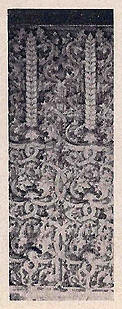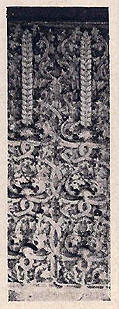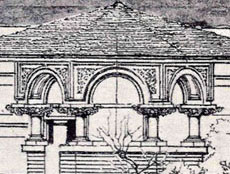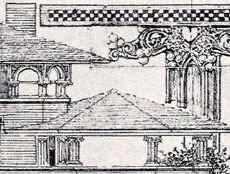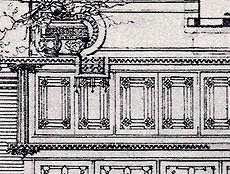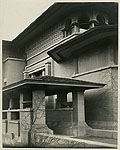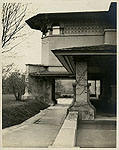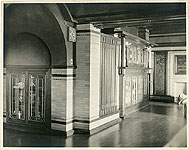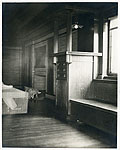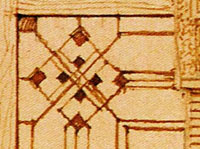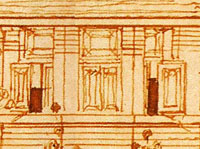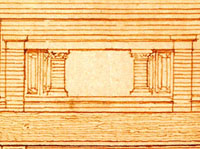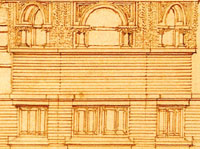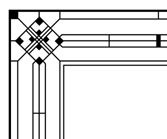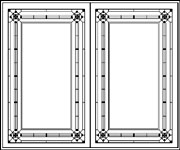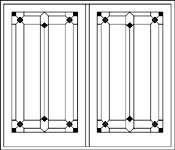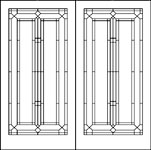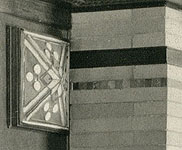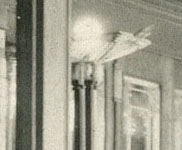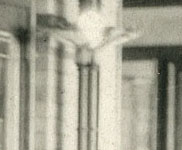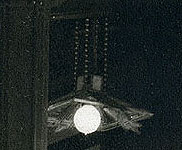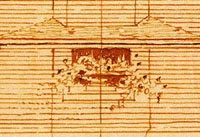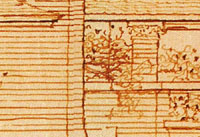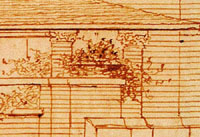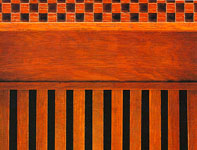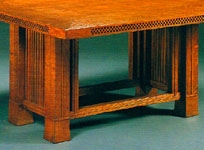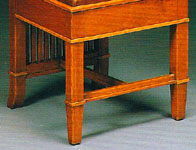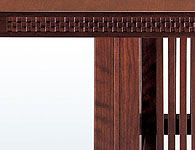|
|
|
Joseph and Helen Husser
Residence, Chicago (1899 - S.046) |
|
|
|
Introduction John Marshall
Williams
Floor Plan
Architectural Review, June 1900
Living Room Fireplace Discovered |
|
Husser Residence Circa 1900
Architectural Record, March 1908
Purcell Photographs 1908 |
|
Reconstruction of East Elevation
Wasmuth Plate IV (1910)
Frank Lloyd Wright, Ausgeführte
Bauten (1911) |
|
Living Room
Fireplace Leaded
Glass Windows and Doors
Light Fixtures Concrete Vases
Dining Room Table & Chairs |
|
Related Items
Corrections Books & Articles |
|
|
|
Introduction |
|
|
|
|
In Frank Lloyd
Wright's
An Autobiography,
he described the Husser home as "characterized to a certain
extent by the Sullivanian idiom, at least in detail"
(p.127). Wright designed the Husser home five years after
the Winslow Residence
(1894), three years after the
Heller Residence
(1896) and two years after the
Furbeck Residence
(1897). It was his last commission utilizing Louis
Sullivan's exterior ornamentations as he moved toward and
perfected his prairie styled homes.
According to their wedding announcement dated March
22, 1894, Joseph J. Husser moved from Zurich, Switzerland to
America for religious reasons. "He was forced to leave home
because he changed from the Catholic to the Protestant
faith. He will teach Christian Science here." The
announcement in the paper read "Married Her Father's
Butler." Although Joseph married into one of the wealthiest
families in Chicago after working as a butler for nearly a
year, the announcement continued, "He comes of a highly
connected family and speaks five languages fluently."
It seems that Helen Husser was the driving force
behind hiring Wright to design their home. It is not
conclusive, but it begs the question, was the home a gift
from John Marshall to his daughter?
Wright placed an announcement in the July 2, 1899
issue of The Economist. "F. L. Wright has designed for Helen
W. Husser a two-story residence to be built at 178 to 182
Buena Avenue. It will extend over an area of 73x 28 feet,
and the cost is given at $18,000. In the June 1900 issue of
"The Architectural Review", Plate XXXVII was entitled "House
for Mrs. Helen W. Husser", but within that same plate, part
of the text reads "Dwelling for Mr. Joseph W. Husser, Buena
Av, Lake View Suburban Lot...". The March 1908 issue of "The
Architectural Record" also entitles a photograph "Mrs. Helen
W. Husser, Buena Park, Chicago". This bears a look at
Helen's father and Joseph's employer and father-in-law, John
Marshall Williams.
Joseph J. Husser, most likely born in Switzerland,
moved from Zurich to America during the early 1890s. He came
from a highly connected family, most likely well educated,
and was fluent in five languages. As indicated in his
wedding announcement, he became a butler for the John M.
Williams household in April 1893. A butler at the
turn-of-the-century managed the household and would be
considered a personal assistant today. He married Helen
Williams in March, 1894. By 1897 the Lakeside Directory of
Chicago listed Joseph as an executive for his
father-in-law's real estate firm located at 140 Dearborn. He
was very involved with the Christian Science movement, and
in 1901, the Lakeside Directory mentions his involvement and
lists the same address. After John Williams past away, he
maintained offices in the same building. In 1906 the
"Directory of Directors" for the City of Chicago listed
Husser as a director of the Park Manufacturing Co. located
on Jackson Blvd. As a director he maintained his office at
140 Dearborn.
Helen Williams' parents were married in 1850.
According to |
|
census records
she may have been born around 1860 in Chicago, the youngest
of seven surviving children. If indeed she was born in 1860,
she would have been 34 years old when she married Joseph in
1894. Shortly after their marriage, she became a member of
the Christian Science Church on June 30, 1894.
Contacting Wright in 1899, Helen and Joseph
most likely moved into their new home halfway through 1900.
In Spencer's June 1900 article in
The
Architectural Review, he comments "A very recent
innovation not yet in place is the facing of gold enamel and
glass mosaic for one of the Husser fireplaces." This would
indicate that the home was built, lacking some of the
finishing details.
When her father past away in 1901, court
documents filed March 24, 1901, indicated that the bulk of
her father's two million dollar estate was divided between
his surviving children and deceased children's children. She
could possibly have inherited close to $300,000, a
small fortune in 1901 (8-10 Million in 2010 dollars).
According to
Irma
Strauss, the Husser Residence was a source of pride
to Wright. On Charles Ashbee's first visited with Wright in
1900, he wrote "...his Husser house over which he took me,
showing me every detail with the keenest delight, is one of
the most beautiful and most individual of creations that I
have seen in America".
By 1910 when Wright published the 100 plate
Ausgefuhrte Bauten, he choose
to only include details of the Husser Residence on Plate IV.
In 1911, when he published "Frank
Lloyd Wright, Ausgeführte
Bauten",
he included three photographs of the Husser Residence, but
that same year he eliminated them from "Frank
Lloyd Wright, Chicago".
Not much can be found about their life in the Wright
designed home. They sold the home in February 1923. When the
home was originally built, it was located about half a block
from the sandy shores of lake Michigan. Lake Shore Drive was
added just after the turn of the century. The extensive land
fill along the shore line east of Lake Shore Drive,
eventually become a golf coarse. The shore of Lake Michigan,
which once could be viewed from the first level, was now
obscured. Today, the area is crowded with apartment
buildings, obscuring any view of lake Michigan from where
the Husser Residence once stood.
A building permit was issued in 1924 and
the Husser Residence was demolished. The Dining Room table
and chairs and a few photographs are all that survive.
The 1930 census recorded that Joseph J. and
Helen G. Husser lived in Los Angeles. Like many retired
couples, they may have owned two homes at the beginning of
the 1920's, finally selling their Chicago home in 1923. In
1919, there was a Joseph J. Husser listed as the First Vice
President of the Los Angeles Symphony Orchestra. Whether the
same, this could place the Hussers in the LA area
1915-1920s.
February 2012
|
|
|
|
|
|
|
|
|
John Marshall Williams (1921-
1901) |
|
|
|
|
|
John Marshall Williams was born
on December 6, 1821 in Alorrisville, NY. His early life was
spent in Morrisville, N.Y., where as a young man he became
successful in the map business traveling throughout the
East, South and Midwest. But he had a desire to move West.
At the invitation of his brother, he traveled to Chicago in
the Spring of 1848, where he opened a lumber yard,
purchasing timber in Michigan. Due to illness, he sold his
business and headed west to mine. He struck gold, but the
work was hard. He invested in capitol in food and goods, and
supplied the camps in California. Upon hearing of his
father's death, headed back to New York, and on July 17,
1850 married Elizabeth C. Smith. They moved back and settled
in Chicago. He became a successful business man in lumber,
groceries, commodity trading and hardware. He invested in
property, was a major stockholder in the First National Bank
of Chicago, and a founder of the Elgin Watch Company. He
invested in lumber lands in Michigan, and as his lumber land
became cleared, rich iron deposits were discovered, and he |
|
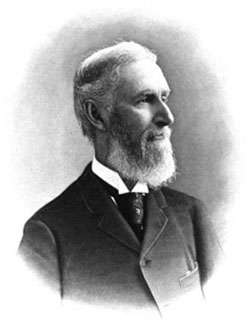 |
|
John Marshall Williams Circa 1894 |
proceeded to
develop the valuable mines in Michigan. Personally he
was very active in his local church, and supported
religious and mission work in Chicago. His estate was
valued at two million dollars at his death. John
Williams past away at his home near Mountain View, CA on
March 9, 1901 at the age of 79.
|
| |
|
|
| |
|
|
| |
|
|
|
|
|
|
|
Floor Plan |
| |
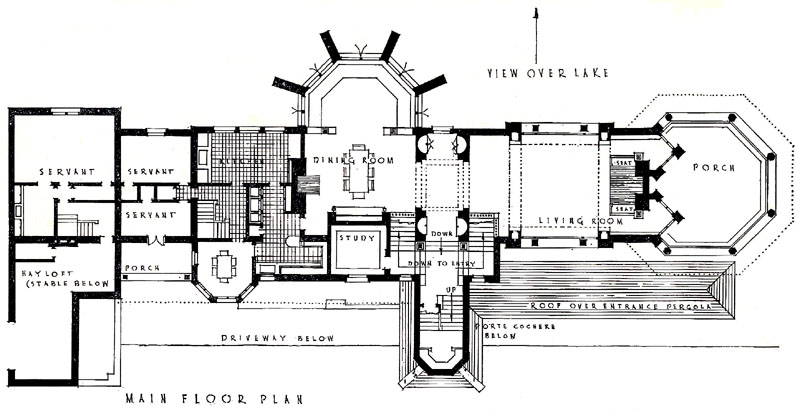 |
| |
|
Floor plan for the First
level. Above the Stable to the left (North) is the
Hay Loft (West side) and the Man's Room or Servants
Room on the east side. Just to the right are two
Servants rooms and a Porch. Next is the Kitchen area
which includes the Kitchen, Pantry and an alcove
which served as a smaller informal Breakfast Dining
Room. Just to the right of the Kitchen area is the
Dining Room that faced East and a Study that faced
West. Much like the windows in Wright's Oak Park
Dining Room, the windows allowed light, but did not
offer expansive views of the lake. Wright choose
rather to keep the it a more intimate setting. To
the right was the Stair Bay (West side). The
Entrance to the home was on the lower level of the
Stair Bay, which lead into the Lower Hall. Double
stairways gave access to the main level and lead to
an Entrance Hall or "foyer" situated between the
Dining and Living Rooms. The Living Room offered
expansive views of Lake Michigan. The Covered Porch
is on the far right. Courtesy of
Henry-Russell Hitchcock, 1942. |
| |
| |
| |
|
|
|
The Architectural Review - June 1901 |
|
|
|
|
During the final stages of
the completion of the Husser Residence, Robert C. Spencer,
Jr. describes the home in the June 1900 issue of
The
Architectural Review. "Among the house plans those
for Mr. Husser and Mrs. Devin (project) are interesting
examples of the ground-floor treated as a basement. The
limitations of narrow lots have been offset by ingenious
planning for light and view, as well as for a dignified
route from street to reception hall. In both these houses
the interior composition is unusually broad and finished
with plenty of the third dimension. Here, as in all his
work, no thin and papery partitions are in evidence, yet
effects of mass and depth are not forced unduly in the
interest of the characteristic, plastic treatment, and
there are no hollow wall spaces which are not organized in
plan to practical purpose... The ornament should be of the
surface, not on the surface and there should be no tangible
background at all. That is the spirit in which the rich
frieze decorations of the Winslow, Heller and Husser houses
are designed...
"A very recent innovation not yet in place is the
facing of gold enamel and glass mosaic for one of the Husser
fireplaces. Quietly framed within broad bands of Caen stone,
the combination of gold in fusion with color on porcelain
have been made to delineate |
|
vine trunks and a weeping
profusion of wisteria sprays and pendent blossoms upon a
ground dull gold below and bright gold above a suggested
horizon. The white joints have been employed with great
skill to delineate dainty stems and leaves of softer green
and crackled gold. The sprays of blossoms are inlays of rosy
white and pearly glass which fall in the airiest, sweetest
fashion from the tangle of leaves above. Mr. Wright as
architect, Miss Ostertag as artist, and Mr. Giannini as
craftsman and burner of remarkable enamels, have co-operated
to show what may be conceived and executed here above and
beyond precedent. They have more than succeeded. No
monochrome can even suggest the exquisite beauty of this
facing in its splendent play of iridescent color, of which
the public has fortunately had a view at the recent
exhibition of the Architectural Club. This bit of mosaic is
for the Husser home, whose interior walls are of a dull
yellow brick engaged with deep toned and unvarnished wood
with inlaid lines of tawny gold mosaic that mark the
beginning of a new epoch in the use of permanent and
beautiful materials for domestic interiors in the west."
This issue included two detailed photographs of the frieze
of the Husser Residence, an illustration of the fireplace,
and Plate XXXVII, seen below. |
|
|
|
|
|
|
|
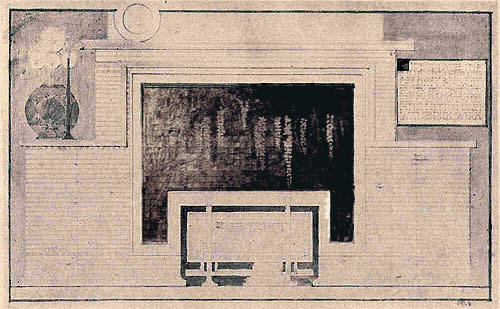 |
| Husser
Residence Fireplace. "A very recent innovation not yet in
place is the facing of gold enamel and glass mosaic for one
of the Husser fireplaces. Quietly framed within broad bands
of Caen stone, the combination of gold in fusion with color
on porcelain have been made to delineate vine trunks and a
weeping profusion of wisteria sprays and pendent blossoms
upon a ground dull gold below and bright gold above a
suggested horizon. The white joints have been employed with
great skill to delineate dainty stems and leaves of softer
green and crackled gold. The sprays of blossoms are inlays
of rosy white and pearly glass which fall in the airiest,
sweetest fashion from the tangle of leaves above. Mr. Wright
as architect, Miss Ostertag as artist, and Mr. Giannini as
craftsman and burner of remarkable enamels, nave co-operated
to show what may be conceived and executed here above and
beyond precedent. They have more than succeeded. No
monochrome can even suggest the exquisite beauty of this
facing in its splendent play of iridescent color, of which
the public has fortunately had a view at the recent
exhibition of the Architectural Club." Published in "The
Architectural Review", June 1900. Continued... |
| |
| Title:
Plate XXXVII - House for Mrs. Helen W. Husser, Buena Ave.,
Lake View, Ill. - Mr. Frank Lloyd Wright, Architect. |
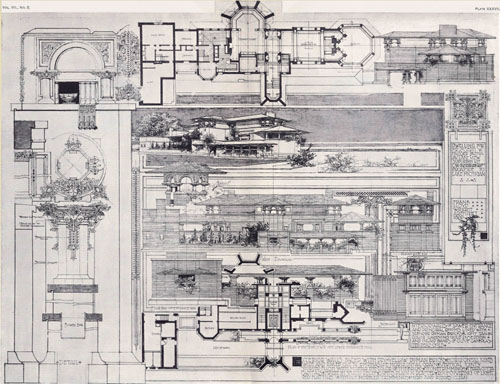 |
|
Inscription
Center Right: "Dwelling for Mr. Joseph W. Husser, Buena
Av. Lake View Suburban Lot. One Hundred and Thirty by One
Hundred Feet. Broadside to Lake Michigan. Frank Lloyd Wright
Architect, 1899...
Continued... |
| |
|
|
|
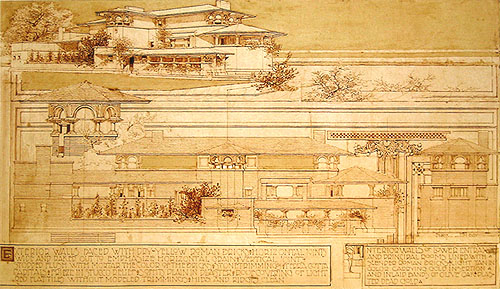 |
| Wright
cropped the illustration and rearranged the text blocks. |
| |
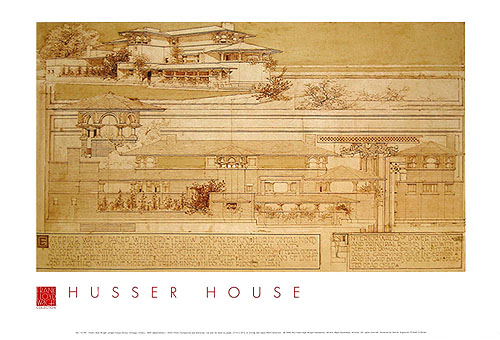 |
| Poster
published in 1998. Husser House (Published by Pomegranate
Communications, Inc., Rohnert Park, CA)
Frank Lloyd Wright:
Joseph Husser House, Chicago, Illinois, 1899 (demolished c.
1923-1924). Perspective and elevation; ink and ink wash on
paper 21 ½ x 37 ½ in. |
| |
| |
| |
|
|
|
Husser Living Room
Fireplace Discovered (Husser, Martin) |
|
|
|
|
It all began with an e-mail from Ted Elliott. "...I came
across an image in The Early Work of Frank Lloyd Wright that
shows a detail of the Martin mosaic - however that didn't
seem right to me and through image comparisons I realized
that it's the Husser mosaic."
Well, we believe he is right. We decided to compare the
Husser fireplace to the Martin fireplace, and the following
is what we found. We followed the timeline.
Figure 1, published in 1900, clearly established the Husser
fireplace, "Mr. Wright as architect, Miss Ostertag as
artist, and Mr. Giannini as craftsman and burner of
remarkable enamels..." |
|
Frank Lloyd Wright chooses to create a collage to portray
the fireplace, a photograph and a drawing, possibly due to
timing. The mosaic may have been completed, as seen in
Figure 3, before the fireplace itself was completed.
Figure 2 is nearly the same drawing of the Husser fireplace
as Figure 1, but misidentified as the Martin fireplace. It
is clearly the Husser fireplace, not the Martin fireplace.
Figure 3 is clearly identified as the Husser "overmantel" by
Manson, and was photographed before it was installed, which
sheds light on the collage in...
Continue... |
|
|
|
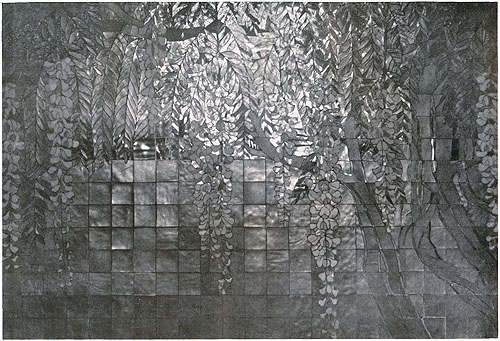 |
Husser Fireplace Discovered.
Figure 5: Joseph & Helen Husser
Residence Fireplace Circa 1900 (1899 - S.046).
This photograph was published in the
Frank
Lloyd Wright Ausgefuhrte Bauten, Wright, 1911, p.110, and in
Frank Lloyd Wright
Chicago, Wright, 1911, p.44. Both are identified as the
Martin
fireplace. AB: "Wohnhaus Martin, Buffalo, N. Y. Kaminwand in Gold-Glasmosaik"
translates "Martin House, Buffalo, N. Y. Fireplace Wall in Gold and Glass
Mosaic." Chicago: "Wohnhaus Martin, Buffalo, N. Y. Mantelverkleidung in
Glasmosaik" translates "Martin House, Buffalo, N. Y. Mantel...
Continue... |
|
|
|
|
|
|
|
|
Husser Residence Circa 1900 |
|
|
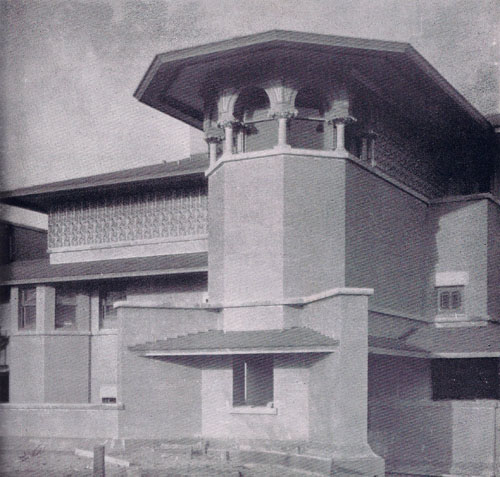 |
|
Viewed from the Southwest. Circa 1900, nearing
completion of construction. The Driveway leads
through the Porte Cochere in the lower level of the
Stair Bay (foreground) to the Stable on the far left
side out of the picture. (Concrete vase missing from
opening in the Porte Cochere.) The Breakfast Dining
Room bay can be seen on the left of the first level.
Just to the right behind the Star Bay is the Study.
The entrance to the home is through the lower level
of the Stair Bay. The Bedrooms are located on the
Second (top) level. Courtesy of the Frank Lloyd
Wright Archives. |
| |
| |
| |
|
|
The Architectural Record - March 1908 |
| |
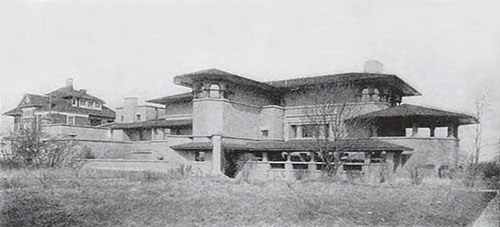 |
| Husser
Residence Circa 1902. Caption: "Mrs. Helen W. Husser, Buena
Park, Chicago". Published in "The Architectural Record",
March 1908. Wright published a total of sixteen articles
entitled "In The Cause of Architecture" in The Architectural
Record from 1908 though 1928. This first article dated March
1908, included one photograph of the Husser home. Although
published in 1908, this photograph was probably taken closer
to 1902. The home directly behind the Husser home has been
built, but the ivy that was visible in 1910 is not. |
| |
| |
| |
|
|
Study of William Gray Purcell Photographs
(1908) |
|
|
|
|
William Gray Purcell
(1880 - 1965) was born and raised in Oak Park. He attended
Cornell University and in 1903 apprenticed with Louis
Sullivan. In 1907 he formed a Architectural partnership with
George Feick in Minneapolis. Two years later George Grant
Elmslie joined the firm. Although never working for Wright,
he followed in Wright's foot steps designing Prairie styled
homes.
According to the Archives, Purcell visited and
photographed the Husser Residence in 1908. |
|
According to
Irma
Strauss, Purcell visited the home in 1911, who noted
"Went through lower floor around 1911 - in bad shape by that
time".
The Northwest Architectural Archives at the
University of Minnesota houses the William Gray Purcell
collection. Included in the collection are five photographs
of the Husser Residence. Two may be the only surviving
record of the interior in existence. The three exterior
photographs...
Continued... |
|
|
|
|
|
|
|
|
|
|
Reconstruction of the East Elevation |
|
|
|
|
|
|
|
With the discovery of
Purcell image three, viewed from the Southeast, we undertook
the task of reconstructing drawings of the East side and
elevation of the Husser Residence. Information of the east
side is very limited. The Floor Plan for the Lower Level is
incomplete. Records are available for the First Level, but
not the second. The North end of the East side is also
incomplete. Image three is out of focus and lacks clarity,
but offers an invaluable record of the East side of the
Husser residence. |
|
Lower level:
Wright designed the Lower level as a basement, although it
was at ground level. This allowed the First floor (middle
level) a better view of Lake Michigan. The Lower Level
housed the utilities, heating, laundry, servant's and
butler's rooms, children's playroom and entry hall. The
Children's Playroom was mostly located below the Living
Room. To the left of the Dining Room Bay is the entry to the
back of the Entrance Hall. Double stairways gave access to
the main level...
Continued... |
|
|
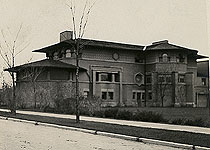 |
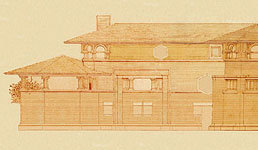 |
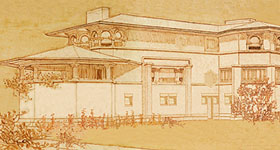 |
|
Photograph (left) courtesy
of the William Gray Purcell Papers, Correspondence file:
Frank Lloyd Wright, Northwest Architectural Archives,
University of Minnesota Libraries, Minneapolis, MN. |
|
|
|
|
|
|
|
|
Wasmuth Plate IV, 1910 |
|
|
|
|
|
In 1910 Frank Lloyd Wright
produced the "Ausgeführte
Bauten und Entwürfe von Frank Lloyd Wright" (S.87),
published by Ernst Wasmuth, in Berlin. Each set consisted of
two portfolios with a combined total of one hundred separate
plates (sheets). Printed in German. The complete set
consisted of 72 plates numbered I through LXIV and included
eight with a or b. 28 were tissue overlays and were attached
to the corresponding plates. Each set also included a 31
page introduction, consisting of unbound |
|
sheets, folded once.
Plate IV
“Perspective and ground plan of a city dwelling for
Isadore Heller, Woodlawn Avenue. Details of Husser house,
Buena Park, Chicago.” 15.75 x 25.25.
A detail of the Husser Dining Room bay window and a
covered Entrance Pergola column appeared on the top right of
Plate IV. This is actually a reprint of a detail in
Plate XXXVII
that was originally published in The Architectural Review,
June 1900. |
|
|
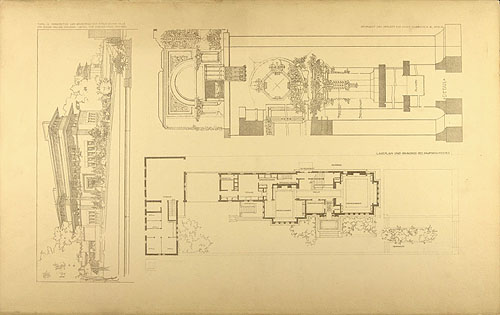 |
|
Plate IV “Perspective and
ground plan of a city dwelling for Isadore
Heller, Woodlawn Avenue. Details of Husser
house, Buena Park, Chicago.” 15.75 x 25.25. |
| |
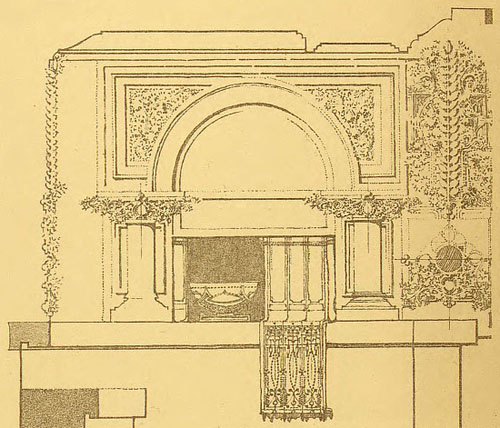 |
|
Detail of the second
level of the Dining Room Bay (East side). Note
Wright's placement of the vase and cloth
tapestry draped from open window. This is
actually a reprint of a detail in
Plate XXXVII
that was originally published in The
Architectural Review, June 1900.
|
| |
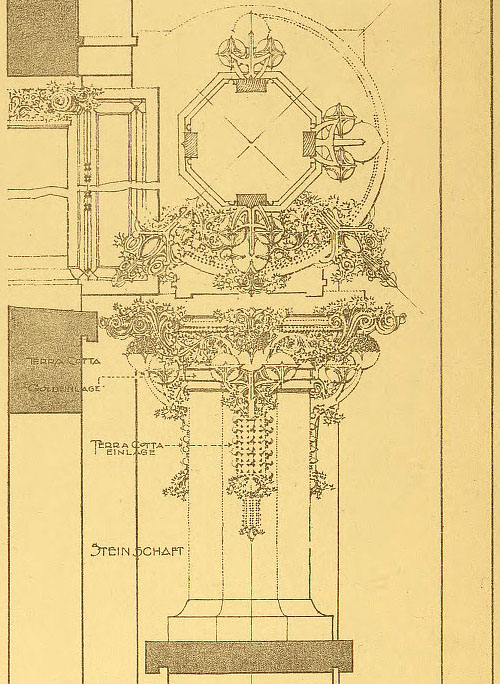 |
|
Detail of the covered
Entrance Pergola column. Three appeared on
either side. This is actually a reprint of a
detail in Plate XXXVII
that was originally published in The
Architectural Review, June 1900.
|
|
|
|
|
|
|
|
|
|
Frank Lloyd Wright, Ausgefuhrte Bauten, 1911 |
|
|
|
|
|
A year after Frank Lloyd Wright
produced the "Ausgeführte
Bauten und Entwürfe von Frank Lloyd Wright" (S.87),
he produced "Frank
Lloyd Wright, Ausgeführte
Bauten"
(Executed Buildings). |
|
All in German, it was published
by Ernst Wasmuth A.-G., Berlin in 1911. Wright included
three photographs of the Husser Residence. |
|
|
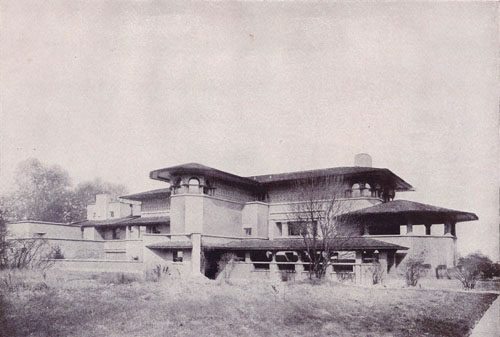 |
|
1) Viewed from the Southwest. Circa 1900. The
Stable (lower level) is on the far left. Just to
the right of the Stable on the first level are
the Servants Quarters and then the Kitchen. The
Dining Room (East side), Stair Bay (West side)
and Entrance (West side) are in the center. The
Living Room is on the right, and Covered Porch
on the far right. The covered Entrance Pergola
to the right of the Entrance is in the
foreground on the lower level. Bedrooms are
located on the Second (top) level. |
| |
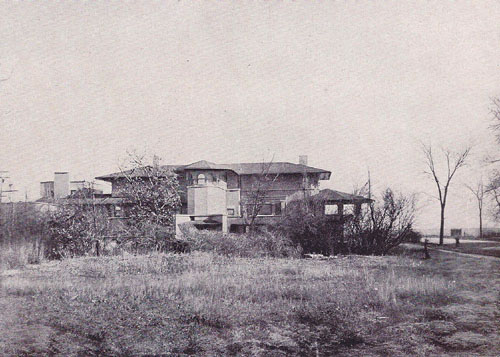 |
|
2) Viewed from the
West. Circa 1900. The Stable (lower level) is on
the far left. Just to the right of the Stable on
the first level are the Servants Quarters and
then the Kitchen. The Dining Room (East side),
Stair Bay (West side) and Entrance (West side)
are in the center. The Living Room is on the
right, and Covered Porch on the far right.
Bedrooms are located on the Second (top) level.
Lake Michigan can be seen in the background on
the far right. |
| |
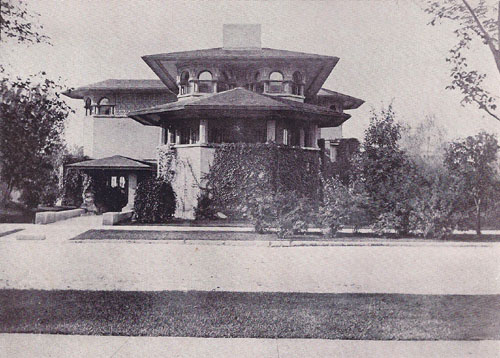 |
3) South Elevation.
Circa 1910. Lower level: On the far left
is the Driveway. From the street, the Drive
leads to the Porte Cochere (blocked from view)
which Wright designed into the lower level of
the Stair Bay. The Driveway leads through the
lower level of the Stair Bay to the Stable. Just
to the right of the Drive is the covered
Entrance Pergola. Both the Drive and the
Entrance Pergola lead to the Entrance and the
Lower Hall.
First level: The Covered Porch is seen in the
foreground in the center. It leads into the
Living Room on the First Level.
First and Second Level: The Stair Bay (West side) can
be seen on the left. The main section of the
house is seen in the center behind the Covered
Porch, and the Dining Room (East side), can be
seen on the right. Bedrooms are located on the
Second (top) level. |
|
|
|
|
|
|
|
|
|
Leaded Glass |
|
|
|
|
|
In June 1900, when Plate XXXVII
was published in
The
Architectural Review, construction of the Husser
Residence was nearly completed. Photographic records give us
scant views of any |
|
leaded glass windows. Plate
XXXVII does give us Wright's intent. The windows of the main
level were drawn in leaded glass, the second level (top
floor) were clear glass.
Continued... |
|
|
|
|
|
|
|
|
|
|
Leaded Glass Windows and Doors |
|
|
|
|
|
Very few examples exist, and
those that do, give us a scant view of the leaded glass
windows and cabinet doors of the Husser Resident. In June
1900, when Plate XXXVII was published in
The
Architectural Review, construction of the Husser
Residence was |
|
nearly completed. Plate XXXVII
give us Wright's design for the upper and lower cabinet
doors of the sideboard.
Purcell's two interior views of also offer a glimpse
of the Hall cabinet doors and a Dining Room Bay...
Continued... |
|
|
|
|
|
|
|
|
|
|
Leaded Glass Light Fixtures |
|
|
|
|
|
Because only two interior
photographs exist, few examples of leaded glass light
fixtures. But the one leaded glass example is very exquisite
and complex. The same fixture is used two different ways.
Two are seen on either side of the Dining Room Sideboard.
The leaded glass light fixture are placed atop a pedestal.
The other is on the opposite side of the Dining Room at the
entrance to |
|
the Dining Room Bay. Either side
of the Bay is a single hanging leaded glass light fixture.
The leaded glass shade matched the two shades of the
Sideboard, but is inversed.
The two Purcell photographs are courtesy of the
William Gray Purcell Papers, Northwest Architectural
Archives, University of Minnesota Libraries, Minneapolis,
MN... Continued... |
|
|
|
|
|
|
|
|
|
|
Concrete Vases |
|
|
|
|
|
Large concrete vases were a
signature design element of many of Wright's Prairie homes.
Wright incorporated five large concrete vases visible in
Plate XXXVII of the Husser Residence, published in the June
1900 issue of
The
Architectural Review. One was |
|
placed in the West opening of
the Porte Cochere. Four were placed in the covered Entrance
Pergola, two on either side of the North end and two on
either side of the South entrance.
Continued... |
|
|
|
|
|
|
|
|
Dining Room Table &
Chairs |
|
|
|
|
|
To date, only one Dining Room
table and eight chairs have survived the destruction of the
Husser residence. According to Irma Strauss, in the
Frank Lloyd Wright Newsletter, First Quarter 1979,
the Husser dining room table and eight chairs were
rediscover after 55 years of use in a private Chicago home.
"The mother of the present owner of the beautiful, almost
square, oak dining room |
|
table and eight elegant,
high slat-back chairs recalls purchasing the ensemble in
1923 from Mr. Steinberg, the proprietor of a second-hand
furniture shop on the near West Side of Chicago. In the shop
were a piano which had been built-in, three similar dining
room tables and 24 matching chairs all of which, Mr.
Steinberg reported, were from a Frank Lloyd Wright... Continued... |
|
|
|
|
|
|
|
|
RELATED
ITEMS |
|
|
|
ITEMS RELATED TO THE HUSSER RESIDENCE |
|
|
|
|
|
|
|
Correction |
|
|
|
|
|
|
|
Text and illustrations Copyright Douglas M. Steiner unless
otherwise noted. |
|
|
|
|
-
Related Books and Articles
|
| |
|
"In the Cause of Architecture",
Wright, Architectural Record, March 1908. |
| "Ausgeführte
Bauten und Entwürfe von Frank Lloyd Wright" Wasmuth,
1910, Detail of the Husser Residence
"Plate IV". |
|
"Frank Lloyd Wright, Ausgeführte Bauten",
Wright, 1911, pages 20-21. |
|
"An Autobiography",
Wright, 1945 (London), Plate 2. |
|
"Frank Lloyd Wright
to 1910",
Manson, 1958, Pages vi, 68, 76-78, 114n. |
|
"In the Cause of Architecture",
1975, Wright, pages 53-119. |
|
"Frank
Lloyd Wright:
Preserving an
Architectural
Heritage, Domino’s Collect",
1989, Hanks, pages 21, 30-31, 62, 114. |
|
"The Leaning Power of Pizza",
Forbes Personal Affairs, 1989, Matthews, Pp Cover, 4-5, 28-33. |
"Frank
Lloyd Wright In His Renderings 1887 -1959",
Text: Pfeiffer, Bruce Brooks;
Edited and
Photographed: Futagawa, Yukio, 1990, Plate 11. |
"Frank
Lloyd Wright Monograph 1887 -1901",
Text: Pfeiffer, Bruce Brooks;
Edited and
Photographed: Futagawa, Yukio, 1991, Pp viii, ix, 54, 86, 120, 139. |
| "The
Frank Lloyd Wright Companion", Storrer, 1993, Page 42. |
|
"Important
Works by
Frank Lloyd Wright
From Domino’s Center",
1993, Christie's,
Pages Cover, 42-45. |
|
"Frank Lloyd Wright: Architect",
1994, Riley, page 61, plates 32-33. |
|
"Frank
Lloyd Wright Glass Art",
Heinz, 1994, page 34. |
|
"Lost
Wright"
Lind, 1996, Pages 39, 52-53. |
|
"The Architecture of Frank Lloyd Wright",
Levine, 1996, pages 28-29. |
|
"Frank
Lloyd Wright:
Cassina I Maestri",
Cassina, 1997, pages 30-31, 42-43. |
|
"Frank
Lloyd Wright
- Field Guide, Vol 2, MetroChicago",
Heinz, 1997, pages 114, 155 |
|
"Frank
Lloyd Wright",
McCarter, 1999, pages 39-41. |
|
"Frank
Lloyd Wright’s
Stained Glass & Lightscreens",
2000, Heinz, pages 51-52. |
|
"The
Vision of Frank Lloyd Wright",
2000, Heinz, pages 377, 388. |
|
"Wright inspired Stools" (Husser),
Woodworker’s Journal, June
2000, pages 32-46. |
|
"Frank
Lloyd Wright:
Year By Year", 2003,
Thomson, page 78-79. |
|
"On and By Frank Lloyd Wright, A Primer
of Architectural Principles",
McCarter, 2005, pages 44-48, 50, 53, 136-39, 142, 193, 207. |
|
"Frank Lloyd Wright,
Complete Works 1885-1916", Pfeiffer: Gossel, 2011, pages
8, 103, 106. |
| |
|
|
|
|
|
|
|
|

CLICK TO ORDER


